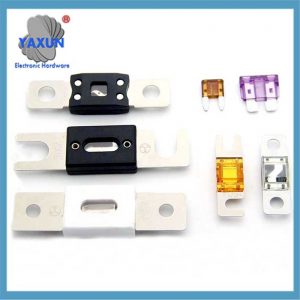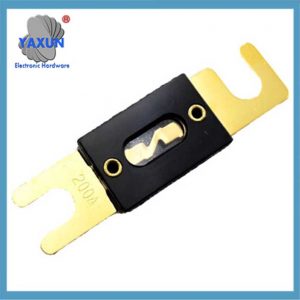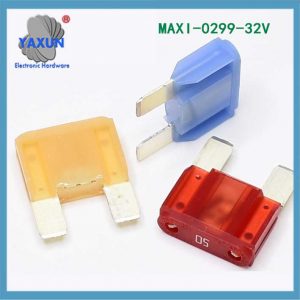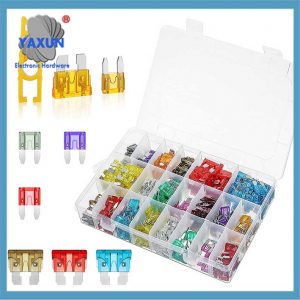Automotive fuses are key protective components in automotive circuit systems, primarily used to prevent equipment damage and fire risks caused by overcurrent or short circuits. The following are their key points:
minä. Basic Functions and Classifications
Core Function
They fuse when the circuit current exceeds twice the rated value, shutting off the current path.
They protect key components and onboard electrical systems, including the ECU, ABS, and lights.
Main Types
Plug-in Type: Current 1-120A, suitable for conventional circuits such as cigarette lighters and windows.
Forkbolt Type: Current 30-800A, suitable for high-power devices such as starter motors.
Glass Tube Type: Current 0.5-80A, mostly used for precision electronic components.
II. Blown Fuses Diagnosis and Treatment
Common Symptoms
The vehicle will not start (the starter motor fuse is blown).
The ABS warning light is on and the speedometer is malfunctioning (the ABS fuse is blown).
Sudden headlight/wiper failure.
Inspection Methods
Visual Inspection: Observe the fuse’s metal connector for a break.
Tester Test: No light on the contacts indicates a blown fuse.
Multimeter Measurement: No buzzer response indicates a blown fuse.
Replacement Guidelines
Use a fuse with the same rated current. Do not substitute copper or iron wire.
Repeated blown fuses require circuit repair; avoid directly replacing with a higher-rated fuse.
III. Safety Precautions
High-Risk Behavior
Tampering with circuits (such as xenon lamp modifications) can increase the blowout rate by 300% due to overload.
Using a low-quality cigarette lighter adapter can cause a short circuit.
Emergency Measures
Temporarily borrow a fuse of the same rating from a non-critical device (such as a 10A fuse for the sunroof circuit).
Jumping critical systems (such as ABS and airbags) is prohibited.
Maintenance Recommendations
Vehicles over five years old should have their fuse contacts inspected for oxidation. Clean the engine compartment fuse box every two years to prevent dust from causing poor connections.
The core function of a car fuse is to shut off the current by melting when an overload or short circuit occurs, Piirin tai laitteen vaurioiden estäminen. Its specific functions are as follows:
Circuit Protection
When the current in a circuit exceeds the fuse’s rated value (usually more than twice the rated value), the fuse will overheat and melt, immediately shutting off the power supply. This prevents the circuit from overheating, shorting, or damaging electronic devices (such as lights, audio, and onboard computers) due to excessive current.
Current Control
By matching the rated current of each circuit device, this ensures stable operation of systems such as lighting, ilmastointi, and window lifts. Esimerkiksi, blade fuses are color-coded (esim., gray for 2A, purple for 3A) to clearly distinguish current ratings, making them easy to identify and replace.
Fault Isolation
Once a fuse blows, it quickly isolates the faulty circuit, preventing the problem from spreading to other systems (esim., separating the engine compartment from the vehicle’s internal electrical systems), simplifying the repair process.
Appendix: Fuse Box Locations
Engine Compartment Fuse Box: Protects external circuits such as the ECU, headlights, and ABS.
Cockpit Fuse Box: Manages internal electrical components such as the cigarette lighter, windows, and airbags.
 English
English Afrikaans
Afrikaans العربية
العربية বাংলা
বাংলা bosanski jezik
bosanski jezik Български
Български Català
Català 粤语
粤语 中文(简体)
中文(简体) 中文(漢字)
中文(漢字) Hrvatski
Hrvatski Čeština
Čeština Nederlands
Nederlands Eesti keel
Eesti keel Suomi
Suomi Français
Français Deutsch
Deutsch Ελληνικά
Ελληνικά हिन्दी; हिंदी
हिन्दी; हिंदी Magyar
Magyar Bahasa Indonesia
Bahasa Indonesia Italiano
Italiano 日本語
日本語 한국어
한국어 Latviešu valoda
Latviešu valoda Lietuvių kalba
Lietuvių kalba македонски јазик
македонски јазик Bahasa Melayu
Bahasa Melayu Norsk
Norsk پارسی
پارسی Polski
Polski Português
Português Română
Română Русский
Русский Cрпски језик
Cрпски језик Slovenčina
Slovenčina Slovenščina
Slovenščina Español
Español Svenska
Svenska ภาษาไทย
ภาษาไทย Türkçe
Türkçe Українська
Українська اردو
اردو Tiếng Việt
Tiếng Việt






for-Car-300x300.jpg)